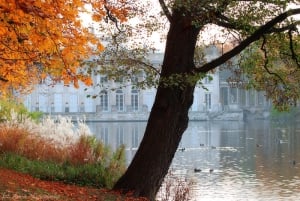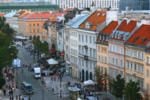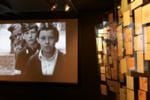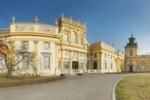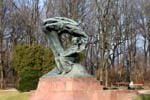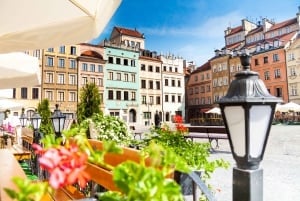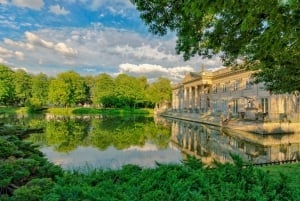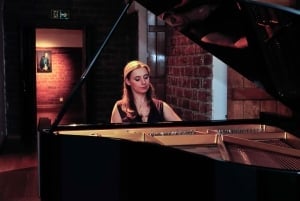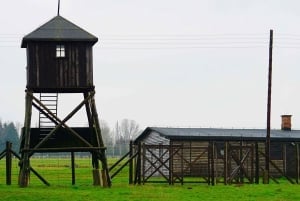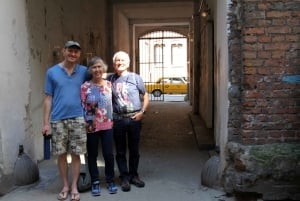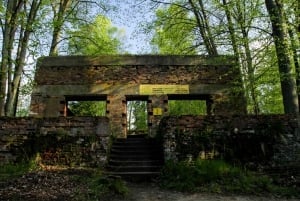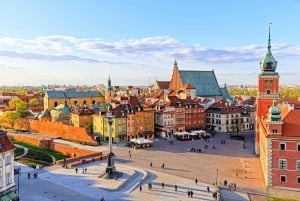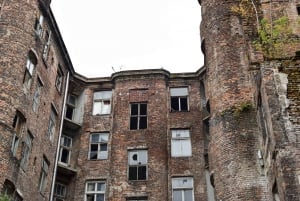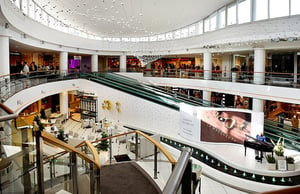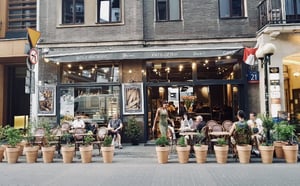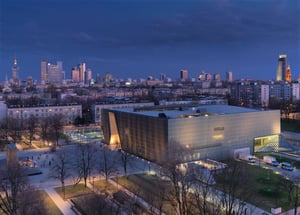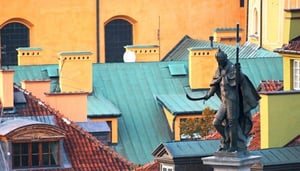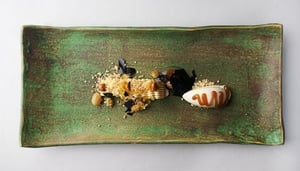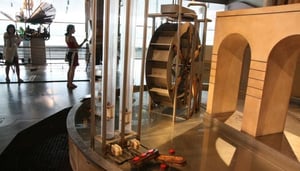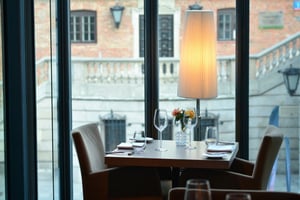Top 10 Attractions
The Old Town
A must-see on any visit to Warsaw, this has to be one of the newest âold townsâ in Europe. Famously re-built from a pile of rubble after WWII, this place oozes charm and tranquility. Leaving Plac Zamkowy, or Castle Square behind you, head off along any of the quiet cobbled streets and see where you end up. The Market Square, with its renaissance buildings, is not to be missed. Even by the Old Townâs standards, this square is surprisingly quiet and has a cozy feel to it - a great place to rest, revitalize and plan your next move. Exploring the quieter streets and alleyways will throw up all sorts of unexpected sights. Hidden courtyards and squares, gardens and statues will delight you as you make your way to Brzozowa (on the eastern side), where the view over the Vistula to the Right-Bank, is one of the loveliest in the city. More info
The Royal Route
This route gets its name from the respective start and end point, The Royal Castle and the suburban royal residence of Wilanow. The Royal Castle and Castle Square owe their capital city status to the man who can be seen standing atop the column in the middle of Castle Square. Late in the 16th century, King Zygmund III moved the capital from to Warsaw, transforming this small centre of trade into the centre of the Renaissance Europeâs biggest empire. Elegance is not a word that springs to mind when one thinks of Warsaw but Krakowskie Przedmiescie has oodles of it. Stroll along the cobbles and take in some of the regal atmosphere of Royal Warsaw. Follow your nose down to the impressive Presidential Palace and the hang out of the 20th century elite, the Hotel Bristol, with its foyer and rooms having kept much of the atmosphere of 100 years ago. Nowy Swiat or New World Street is where old meets new with some of the best shops and dining in some of Warsawâs oldest townhouses. Look out for Foksal Street, just off Nowy Swiat, for a quiet time-out and a coffee in one of its many cafes. Plac Trzech Krzyzy (Square of The Three Kings) was an important crossroads on the Royal Route but it is now more famous for the high end shops you can find around the edges. A large plastic palm tree signals the end of Nowy Swiat at Rondo de Gaulle. This controversial 15-metre piece of art now symbolizes new Warsaw. The Royal Palace at Wilanow is one of the few major buildings to survive WWII and, as such, is well worth a look as there is so much to do here.
Lazienki Park
As city parks go, Lazienki is a gem. Warsavians rightfully feel proud of their very own âgreen lungâ and you will see why as you wander along its central route, Ujazdowskie Avenue. Each step takes you further away from city noise and offers complete urban respite from the usual wearisome elements of a modern capital. Lazienki has everything you would expect from a city park including a superb central lake (with its own Palace on the Water), an amphi-theatre, stately residences, an orangery and free Chopin concerts during the summer. You begin to realize the scale of this park as you come across its numerous attractions. But this is the best thing about it. As one would expect in a city like Warsaw, it is popular on a sunny day. Fortunately, you never feel like you have to fight for some peace and quiet here. Even on a busy weekend, it is still easy enough to find a quiet shady nook or wander the well-tended lawns and winding paths in relative isolation. As a remedy to what awaits back in the Cap, you will find yourself returning again and again. More info
Warsaw Rising Museum
The Uprising of 1944 is remembered as a historic event that highlighted the struggle and determination of a crushed population against its occupiers. It was the biggest rebellion of its kind and came at a terrible cost of life and destruction. Today, its significance is not forgotten and no visit to Warsaw would be complete without a trip to this jaw-dropping installation. The Museum, opened in 2004 in an old tram power station, takes the visitor on a truly interactive journey from pre-Uprising occupation, culminating in a state-of-the-art 3D aerial film of the total destruction of the city. The feel of the place is totally absorbing thanks to the amount of detail and exhibits that vie for your attention. Follow the steel monument time line that rips straight through the floors of each level to the Peace Garden on the roof, where you can see the Memorial Wall and the names over the 10,000 that perished. The whole experience results in a memorable addition to any itinerary. More info
Praga District
For a taste of something completely different from the glitz and concrete of down town Warsaw, head for this rundown, up and coming, once no-go zone. We might be being a bit harsh on Praga, situated in the eastern part of the city, but it is definitely worth a look. Boasting some of the oldest buildings in the city (it was left relatively in-tact after WWII), it is undergoing something of a renaissance right now. Where once it was considered unsafe for westerners, now it has a bubbling artsy under-current that soon promises to totally transform the district into a culture/café/night life hub. Having said that, there is no escaping the charm of this place. Itâs not just the number of original buildings, which having been renovated, now house various galleries and the like, Praga has other, more unsuspecting attractions like its lovely Skaryszewski and Praski parks where you can take in open-air concerts, admire some sculpture or simply wander and soak it all up. It is true that Praga is changing. See it now and enjoy the rough edges mixed and mashed with the smoother ones. If you are looking for a polar opposite to the chocolate-boxy loveliness of the OT, Praga has everything and more. More info
Wilanow
Warsawâs very own Palace of Versailles is quite something. A fitting reward for walking the entire length of the Royal Route, this sprawling building remained virtually undamaged after WWII and is a glorious reminder of Polandâs regal history. Highlighting both Polish and European architectural styles, the Palace has a strange look to it. It was built for one of Polandâs most famous leaders, King Jan Sobieski III and inside and out, the walls are adorned with images of some of the Kingâs most famous military victories. It changed hands many times over the years and became a favoured summer house for those that lived there. The result is a style based on many different influences and tastes, which makes a look around the interior a must. The grounds are a pleasant continuation having looked around inside. The French-designed lawns and gardens offer a peaceful wander before you check out the poster museum, the biggest of its kind in the world. All in all, Wilanow is a great day trip away from the city centre and well worth the effort. More info
Bars and clubs
As you would expect in a country famous for a zillion types of vodkas and a penchant for strong beer, Warsaw has nightlife aplenty. Should you fancy a quiet one or an all-nighter, this city can deliver. There are simply too many good options to mention here â you will need to do some serious research first. If you want to dress up and party with the new money, head to the areas around Nowy Swiat, Plac Trzech Krzyzy or Plac Pilsudskiego. If you left your best dress at home, head for the bo-ho Praga district, with itâs up and coming art scene and lively nightlife. If you are looking for something a tad different, try Warszawa Powisle where you can mix vodka and culture in this hip restored modernist railway ticket office. If you want to sample something more hedonistic, Warsawâs nightclubs are up there with the best of them. Donât miss the likes of cult-ish Klub Balsam or Klubo Kawiarnia for full-on funky. Still not sleepy? Try Eve, the cityâs official after-party venue and hedonistâs dream come true. We havenât mentioned so many here but some further reading is well worth the effort before planning a night out in this eclectic town. Definitely something for everyone. More info
Copernicus Science Centre
When you have had enough of shopping, architecture or just want something different, you could do much worse than spending a totally absorbing half a day at the Copernicus Science Centre. This place was opened in 2010 as a result of open-air science picnics where you could munch on your ham sandwich while meddling with the laws of physics. And a good thing it was too. For this place is a haven for anyone with a passing interest in all things scientific. First impressions are space-age as the building, sitting on the banks of the Vistula, could be a setting for a modern Dr Who story. But the real excitement is inside. What better way to start than interacting with a talking robot before you explore the 5 experiment areas that cover a wealth of scientific whizz and bang. You will not be short of ideas of what to look at next as there really is something for everyone and all ages (including preschool children). As science museums go, this one is right up there in a button-pushing, interactive age of low boredom thresholds. Check ticket availability first to avoid disappointment. More info
Chopinâs Warsaw
Warsaw has plenty of top-drawer museums and this one, paying homage to the cityâs most famous son, is a rewarding distraction and a pleasant reminder that âcultureâ doesnât have to be boring. Completely renovated and revamped to mark his 200th birthday in 2010, the Chopin Museum succeeds in bringing its subject to life through a marvelous array of innovation. Follow different routes and commentaries brought to life through the senses of sight, sound and smell. Walk the streets of 19th century Warsaw or Chopinâs Paris and feel immersed in the great manâs time and space. Itâs not all modern-day museum trickery. Some of the most important artifacts and memorabilia have been lovingly assembled and presented including original manuscripts and printed works as well as photos and early recordings. By recreating different aspects of the life of Chopin this museum will appeal to both the hardcore Chopin fan and the merely interested. Added to all this are the piano recitals that are held in the museum that add a touch of extra colour to this sensory experience.
Jewish Warsaw
Today Warsaw is a city that has shrugged off its dour grey reputation and replaced it with something much more desirable â a city you want to spend time exploring. The cityâs history is partly responsible for this, being both intriguing and tragic. One chapter that has both those elements is to be found in the Jewish district. After total destruction of these neighborhoods in 1943, they were never rebuilt and only traces remain. Made up of monuments, gravestones and empty lots where Jewish institutes once stood, this fundamental part of Warsawâs history still lingers in the mind and is worth exploring. A good place to start is the Jewish Historical Institute nearby Plac Bankowy. This educational centre shares the rich culture of Jewish Poland through archive material, documents and photos. Namely among them is the Ringelblum Archive, a staggering first-hand account of life in the infamous ghetto which is now considered the definitive text of the period of German occupation. Traces of Jewish Warsaw are to be found all over the city. A little exploring will result in a somber but fascinating experience unearthing some of this cityâs chequered past. More info



